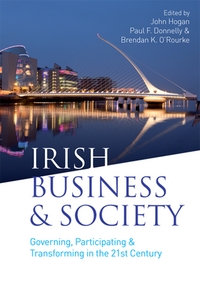Cultural tourism development in Irish villages and towns: the role of authenticity, social, cultural and tourist capital
McCarthy, Breda (2010) Cultural tourism development in Irish villages and towns: the role of authenticity, social, cultural and tourist capital. In: Hogan, John, Donnelly, Paul F., and O'Rourke, Brendan K., (eds.) Irish Business & Society: governing, participating & transforming in the 21st Century. Gill & Macmillan, Dublin, Ireland, pp. 418-437.
![[img]](https://researchonline.jcu.edu.au/17713/4.hassmallThumbnailVersion/17713_McCarthy_2010_front_cover.jpg)
|
Image (JPEG) (Book Cover)
- Cover Image
Download (169kB) |
|
|
PDF (Published Version)
- Published Version
Restricted to Repository staff only |
||
|
PDF (Accepted Version)
- Accepted Version
Download (205kB) | Preview |
Abstract
[Extract] The term 'cultural economy' (and cultural tourism) signifies the transformation of a production-oriented economy to a consumption-oriented one and the greater importance of 'invisibles' in capitalist society (du Gay, 1997; Leadbeater and Oakley, 1999; Scott and Urry, 1994). The cultural economy, as a concept, is supported by policy makers around Europe and appears in many policy statements and strategy documents. Cato et al., (2007) highlight that creative industries have the potential to enrich and stabilise disadvantaged areas, as well as generating direct economic benefits. Products and services, such as, film, music, fashion, design, dance, theatre, art and crafts, are generally categorised as 'cultural goods', which are defined by Hirsch (1972: 641) as 'non-material goods directed at a public of consumers for whom they generally serve an aesthetic or expressive, rather than a clearly utilitarian function'.
Academics and policy makers now recognise that cultural tourism is a 'living' (not simply representations of the past), socio-cultural construction. In other words, its social connotation is not given, but negotiated and different people may conceive it in different ways (Cohen, 1988). For instance, the appeal of a city often comes from its physical assets and experiences built around those assets, which generally extend to the 'living culture' and the atmosphere of the place (Wilson, 2002). Tourists are often attracted to destinations that are linked to art history or contemporary performance (Gibson and Connell, 2003; Hughes, 2000; Hughes and Allen 2005). As cultural tourism is increasingly utilised as a means of economic development, the need for creative tourism projects is greater than ever. Increasingly, experiences, such as, learning how to dance in situ, in the original traditional setting, are being marketed to cultural tourists (Richards and Wilson, 2006).
According to Fáilte Ireland (2009), cultural tourism embraces the full range of experiences visitors can undertake to learn what makes a destination distinctive – its lifestyle, its heritage, its arts, its people. Cultural tourism in Ireland consists of three key sectors: traditional culture, living culture and the built heritage. Heritage tourism has been conceptualised as 'gazing on the past' (Urry, 1990). In the 1980s, the availability of European Union (EU) funding for capital projects led to a flood of heritage and museum projects in Ireland (McGettigan and Burns, 2001; Stocks, 1996). In the 1990s, the marketability of culture and the shift to 'invisibles' came to the fore in Irish tourism. Marketing campaigns sought to capitalise on Ireland's fashionable image and success in music, literature, theatre, film and dance. According to Nicholls (2000), myths and stereotypes help shape tourists’ expectations. In the case of Ireland, the success of Riverdance, Guinness and the Irish pub, along with rock artists on an international stage (Ó Cinnéide, 2005; Strachan and Leonard 2004), have all helped build a brand and re-enforce the conception of Ireland as a musical nation. Developed from a five-minute dance routine commissioned for the interval of the Eurovision Song Contest in 1994, Riverdance epitomised the revival and contemporisation of Irish culture. In the 1990s, marketing campaigns developed the themes of activity, authenticity, culture, friendliness and memorable personal experiences, summarised as 'emotional experience positioning' (Prentice and Anderson, 2000). Irish Tourism attempted to present Ireland not so much as a place to see, but as a place to experience, combining its historical features with more contemporary ones (Johnson, 1999).
| Item ID: | 17713 |
|---|---|
| Item Type: | Book Chapter (Research - B1) |
| ISBN: | 978-0-7171-4990-2 |
| Date Deposited: | 11 Oct 2011 04:57 |
| FoR Codes: | 15 COMMERCE, MANAGEMENT, TOURISM AND SERVICES > 1506 Tourism > 150601 Impacts of Tourism @ 60% 15 COMMERCE, MANAGEMENT, TOURISM AND SERVICES > 1505 Marketing > 150503 Marketing Management (incl Strategy and Customer Relations) @ 40% |
| SEO Codes: | 90 COMMERCIAL SERVICES AND TOURISM > 9003 Tourism > 900302 Socio-Cultural Issues in Tourism @ 50% 97 EXPANDING KNOWLEDGE > 970115 Expanding Knowledge in Commerce, Management, Tourism and Services @ 50% |
| Downloads: |
Total: 8870 Last 12 Months: 16 |
| More Statistics |



